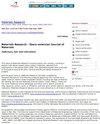Effect of Surface Modified Montmorillonite Nanoclay on Tensile and Flexural Properties of Pineapple Leaf Fiber Reinforced Epoxy Composite
IF 1.5
4区 材料科学
Q4 MATERIALS SCIENCE, MULTIDISCIPLINARY
Materials Research-ibero-american Journal of Materials
Pub Date : 2023-03-24
DOI:10.1590/1980-5373-mr-2022-0437
引用次数: 0
Abstract
Due to their biodegradability, affordability, low density, and numerous other benefits, natural fiber polymer composites are preferable to conventional GFRP in maritime applications. However, when exposed to moisture, their mechanical qualities deteriorate. A significant agricultural waste called pineapple leaf fiber (PALF) can be employed as reinforcement in epoxy matrices. Improved interfacial bonding between phases improves interfacial bonding and hence enhance mechanical and water absorption properties. Only evaluation of mechanical properties is undertaken in this paper. Nanoclay in 1.5 and 3 wt% was incorporated in epoxy resin via magnetic stirring and ultrasonication. PALF fibers were subjected to NaOH treatment and was analyzed using SEM and FTIR techniques. Hand layup and compression moulding were used to fabricate composites using a nanoclay-epoxy resin combination and chemically treated PALF (20 & 30 wt%). The combination of 30 wt% PALF and 1.5 wt% nanoclay results in the maximum mechanical properties, namely tensile and flexural properties. The results of SEM investigation of fractured specimens show that interfacial bonding in epoxy composites containing PALF is poor while that in epoxy composites containing PALF and 1.5 wt% nanoclay is excellent. Due to nanoclay agglomerations, bonding is inadequate at 3 wt% nanoclay, which lowers the mechanical properties.表面改性蒙脱土纳米粘土对菠萝叶纤维增强环氧复合材料拉伸和弯曲性能的影响
本文章由计算机程序翻译,如有差异,请以英文原文为准。
求助全文
约1分钟内获得全文
求助全文
来源期刊

Materials Research-ibero-american Journal of Materials
MATERIALS SCIENCE, MULTIDISCIPLINARY-
CiteScore
2.40
自引率
11.80%
发文量
161
审稿时长
3 months
期刊介绍:
Information not localized
 求助内容:
求助内容: 应助结果提醒方式:
应助结果提醒方式:


